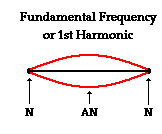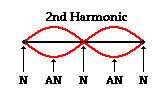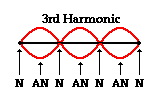Harmonics and cool math

| Harmonics |
| In other sections, we
gave an overview of the natural frequencies of an object.
Someone who plays a stringed instrument would be able to
change the natural frequency of their instrument by
changing the length of one or more of their strings. There
is a particular relationship between the length of an
instrument's string and the frequency of sound it
produces. That is... fn = v/λn = nv/2L When n=01 this is the fundamental frequency and the lowest note that could be produced by an object. When n=2, we have the second harmonic frequency. When n=3, we have the third harmonic frequency, and so on.    From the pictures, we see that each harmonic adds one node and one antinode to the standing wave pattern. |
| Ratios between Harmonics |
Knowing some of the basic
physics behind sound frequencies, we can put a lot of
physical meaning behind terms that are thrown around in
music theory. The following is a table relating whole
number ratios of frequencies to terms used in music.
|